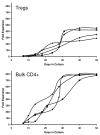Expanded nonhuman primate tregs exhibit a unique gene expression signature and potently downregulate alloimmune responses
- PMID: 18801023
- PMCID: PMC2874242
- DOI: 10.1111/j.1600-6143.2008.02376.x
Expanded nonhuman primate tregs exhibit a unique gene expression signature and potently downregulate alloimmune responses
Abstract
We have established two complementary strategies for purifying naturally occurring regulatory T cells (Tregs) from rhesus macaques in quantities that would be sufficient for use as an in vivo cellular therapeutic. The first strategy identified Tregs based on their being CD4+/CD25(bright). The second incorporated CD127, and purified Tregs based on their expression of CD4 and CD25 and their low expression of CD127. Using these purification strategies, we were able to purify as many as 1x10(6) Tregs from 120 cc of peripheral blood. Cultures of these cells with anti-CD3, anti-CD28 and IL-2 over 21 days yielded as much as a 450-fold expansion, ultimately producing as many as 4.7x10(8) Tregs. Expanded Treg cultures potently inhibited alloimmune proliferation as measured by a carboxyfluorescein succinimidyl ester- mixed lymphocyte reaction (CFSE-MLR) assay even at a 1:100 ratio with responder T cells. Furthermore, both responder-specific and third-party Tregs downregulated alloproliferation similarly. Both freshly isolated and cultured Tregs had gene expression signatures distinguishable from concurrently isolated bulk CD4+ T-cell populations, as measured by singleplex reverse transcriptase-polymerase chain reaction (RT-PCR) and gene array. Moreover, an overlapping yet distinct gene expression signature seen in freshly isolated compared to expanded Tregs identifies a subset of Treg genes likely to be functionally significant.
Figures










References
-
- Meier-Kriesche HU, Schold JD, Kaplan B. Long-Term Renal Allograft Survival: Have we Made Significant Progress or is it Time to Rethink our Analytic and Therapeutic Strategies? Am J Transplant. 2004;4:1289–1295. - PubMed
-
- Newell KA, Larsen CP, Kirk AD, Newell KA, Larsen CP, Kirk AD. Transplant tolerance: converging on a moving target. Transplantation. 2006 Jan 15;81(1):1–6. - PubMed
-
- Newell KA, Larsen CP. Toward transplantation tolerance: a large step on a long road. Am J Transplant. 2006 Sep;6(9):1989–90. - PubMed
-
- Kean LS, Gangappa S, Pearson TC, Larsen CP. Transplant tolerance in non-human primates: progress, current challenges and unmet needs. Am J Transplant. 2006 May;6(5 Pt 1):884–93. - PubMed
-
- Nikolich-Zugich J, Slifka MK, Messaoudi I. The many important facets of T-cell repertoire diversity. Nat Rev Immunol. 2004;4:123–132. - PubMed
Publication types
MeSH terms
Substances
Grants and funding
- P01 AI056299/AI/NIAID NIH HHS/United States
- R01 AI040519/AI/NIAID NIH HHS/United States
- U19 AI051731/AI/NIAID NIH HHS/United States
- P51 RR000165/RR/NCRR NIH HHS/United States
- 5U19-AI051731-02/AI/NIAID NIH HHS/United States
- R01 AI 34495/AI/NIAID NIH HHS/United States
- R01 AI034495/AI/NIAID NIH HHS/United States
- R01 HL056067/HL/NHLBI NIH HHS/United States
- CA72669/CA/NCI NIH HHS/United States
- R01 CA072669/CA/NCI NIH HHS/United States
- P01 AI044644/AI/NIAID NIH HHS/United States
- 5P01-AI044644-07/AI/NIAID NIH HHS/United States
- 1K08AI065822-01A1/AI/NIAID NIH HHS/United States
- P51-RR000165-45/RR/NCRR NIH HHS/United States
- 5R01-AI40519-07/AI/NIAID NIH HHS/United States
- K08 AI065822/AI/NIAID NIH HHS/United States
LinkOut - more resources
Full Text Sources
Other Literature Sources
Research Materials

